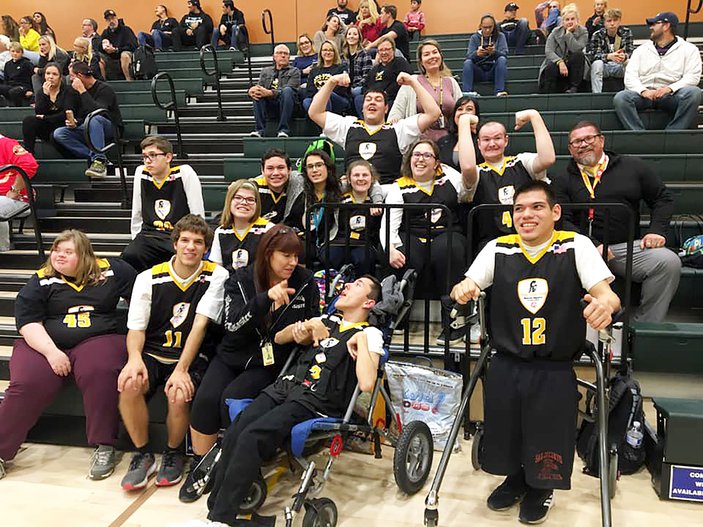
With passion and commitment from students, staff, teachers and leaders, as well as assistance from Special Olympics, Yucca Valley High School has created unified sports, activities and other opportunities for all students.
Unified Champions: Taking the path to inclusive enlightenment
April 15, 2024
The following article was written by Justin Monical, principal at Yucca Valley High School (Morongo Unified School District).
A very fine line exists in school administration between the art and science of education. Both represent complicated worlds with interwoven cogs, domineering personalities and passion projects which can often fall in competition with one another. Finding the ability to balance competing priorities in an industry driven by measurable, positive outcomes is not easy. The science of education is, simply put, about systems engineering and data-driven decision making. Solid systems enable even mediocre professionals to maximize their potential and improve student learning, but the art of education is solely reliant on the gifted abilities of amazing professionals who have the unique talent of seeing beyond who we are and unlocking who we can be. It is the art that inspires us.
Show me a great school, and I will show you an amazing team of educators who set a high bar for not only their students but themselves. Great educators exist, and will continue to do so, without great schools, but great schools cannot exist without great educators. Successful schools are built by great educators empowered and enabled by sound systems. Throughout my 27 years in a very complicated business of public education, I have seen many amazing educators who rise like phoenixes from the ashes of underperforming schools. They exist in every corner of the American public-school system fabric — teachers who transcend circumstances and inspire those around them, mostly their students, to strive for something more, something better.
In 2018, I was approached by our adaptive physical education teacher, Angela Gay, and our SELPA Director, Heidi Burgett, with an idea of partnering with the Special Olympics of Southern California to become a Unified Champion School. I had no idea what I was about to get into, but when Angela and Heidi came knocking, I knew I had to listen. The need for integrating our student body, both special education and general education, in an effort to become an inclusive school where students of all abilities were seen and treated as peers was evident. We could no longer stand by and witness inclusion, dignity and equity be underrepresented philosophies at our school.
A date was set to meet with the area representative for the Special Olympics. I have never been sold so hard on a program that didn’t cost a penny. I was presented with pamphlets and posters, fliers and Unified Champions swag. About 20 minutes in, I told everyone to stop. I had heard enough. I couldn’t take any more of the sales pitch. They had me at “hello.” How could this not be a winner? How could this be anything but life-changing for our students and faculty?
What is Unified Champions? The term “Unified Champions” is associated with Special Olympics programs that promote inclusive sports and activities in schools. These programs typically aim to bring together students with and without intellectual disabilities to participate in sports and other activities on the same team. And that is what we wanted: Our students needed to be on the same team. It couldn’t just be talked about — it needed to be felt in every nook and cranny of our campus.
Unified Sports, a program developed by the Special Olympics to promote social inclusion through shared sports training and competition experiences, provided our school with the plan, tools and financial resources to launch this program. It was that easy. Our only obligation was to commit to being a better version of us and doing it the Special Olympics way, “demonstrating courage, experiencing joy and participating in a sharing of gifts, skills and friendship.”
It aided in creating a school environment that fosters understanding, acceptance and friendships among students of all abilities. Soon, everyone was on board. The teachers in the moderate-to-severe special education program soon started the Better Together Club. The club organized one of the most remarkable events ever, Fun with Friends. During October, which is Disability Awareness Month, teams of teachers, paraprofessionals and students with and without disabilities organized a day where students of all abilities could participate in activities that, although entertaining, mimicked situations for individuals with disabilities. All of our students were overwhelmingly engaged.
The endeavor started small, as most successful feats tend to. The most significant initial step was resisting the urge to start with the typical administrator response: “No.” In school administration, we often see barriers and boundaries from our starting blocks rather than potential. In this case, the response was simple. It was, “Yes. How can I help?” And so it began, a journey that is now five years in the making and a lifelong endeavor which will transcend generations of students.
Like all successes, we started small and dreamed big. The vision was simple. Our students needed to feel valued, important and included. Inclusive events like basketball games with peers and participation in ASB activities such as the Lip Sync Battle gave way to the most life-changing of all — Unified PE. The brainchild of Coach Angela, Unified PE became a venue for intellectually and physically disabled students to participate in mainstream activities with their general education peers on a daily basis. The result was unbelievable.
Adorned with their own uniforms, our Unified Champion students competed in a basketball game at an all-school assembly. To say we were nervous would be an understatement. We had no idea how our student body would respond. When Audra drained her first two-point shot, the student body erupted as though we had just won the state championship. Moments like that will not be soon forgotten. The event was led by Sierra, a student with disabilities, who brought the entire gym to a standing ovation with her rendition of “The Star-Spangled Banner” that would have put Mariah Carey to shame. The performance was so amazing she returned for an encore at the school’s Senior Night for both boys and girls basketball.
... We had awakened into a whole new way of thinking. Inclusion wasn’t about new programs especially designed to be inclusive. Inclusion had to be a part of every tradition our school held dear.
One can imagine the resonance moments like those have on our students with exceptional needs, but it was the general education peers who grew the most. Initially, we sought peers who had the maturity and capacity to lead and include. By the end of year three, we became far more strategic. Because we could see the changes that were happening with some of the best and brightest, we believed we could overcome challenges with some of our general education students who needed some of our peers with disabilities far more than those peers with disabilities needed them. The results were mind boggling, and the positivity began to spread.
Before we knew it, our sister school started a Unified Program followed by the junior high feeder schools. This was getting big. Events between and with the other schools were hosted. At the inaugural Unified Kickball Tournament, we transitioned between innings. I went to assist one of our players, Alejandro. I encouraged Alejandro to move from the field to the plate as it was his turn to kick. His peer buddy immediately stopped me, “Sir, this is a transition for Alejandro. It takes him a little time, but he understands. He will get there.” Alejandro took her hand, and off they went. Not bad for a 15-year-old peer buddy. The experiment was working.
As the energy from the program began to infiltrate the campus, soon we had everyone wanting a piece of it. We set out to have a Unified Leadership class where students with and without disabilities could collaborate in programs that led the school. It was then that we had our greatest epiphany. It struck us like lightning. Why on earth would we need to have Unified Leadership? If we had grown so much with equity and inclusion, why would we need a new class? Why would we have to write curriculum for a new course? Why wouldn’t our students with intellectual disabilities just be included in the existing course like everyone else? Bingo! That was it — we had awakened into a whole new way of thinking. Inclusion wasn’t about new programs especially designed to be inclusive. Inclusion had to be a part of every tradition our school held dear.
We had gone all in with inclusion. Inclusion had turned to compassion, and from that compassion spawned a self-awareness of needing to be better. And better we were — better together. Almost daily, the plans and activities continue to grow. Angela can often be found with our behavior analyst, David, conceiving new ideas that show just how far we’ve come. I regularly accuse them of conspiring to bring me into another one of their hairbrained ideas. They often laugh in response, “We are not conspiring. We are inspiring!” That’s the truth.
There are enormous takeaways from this new “normal” at our little high desert school. First, as an administrator, stop asking “Why?” and start asking “Why not?” Let amazing people run with great ideas. Move the obstacles, including yourself. Next, trust the hearts of our youth. The protective and nurturing instinct of human beings is strong. It will grow and rise. Last, understand that there is no destination. This is a forever journey. It is a journey that will challenge norms, reshape thoughts and actions, and fill hearts.
#WeAreYV.
Yucca Valley High School student Jesse with Board Member Chris Claire.
Yucca Valley High School student Alijah plays kickball, one of many activities at the school that are now inclusive for all students, including special education students.
Students at Yucca Valley High School held a Lip Sync Battle, a unified activity that brought special education and general education students together.





